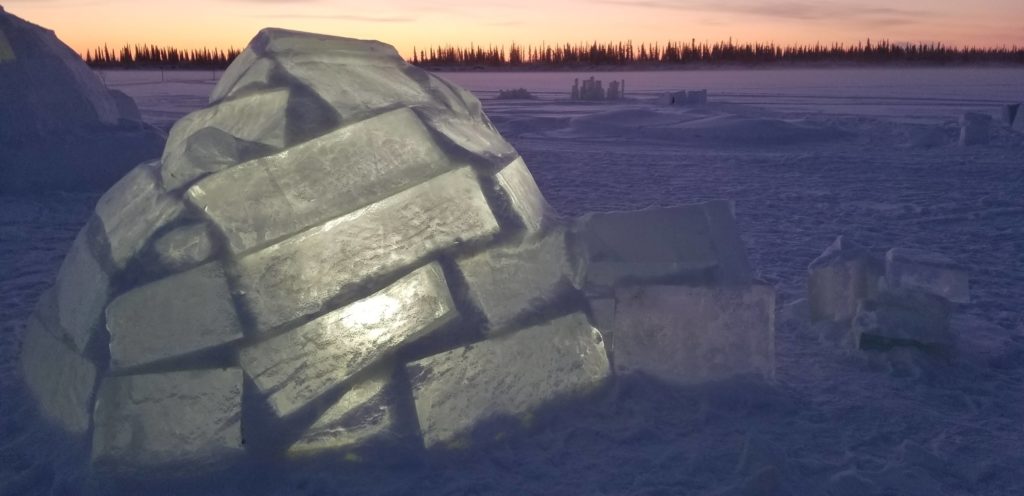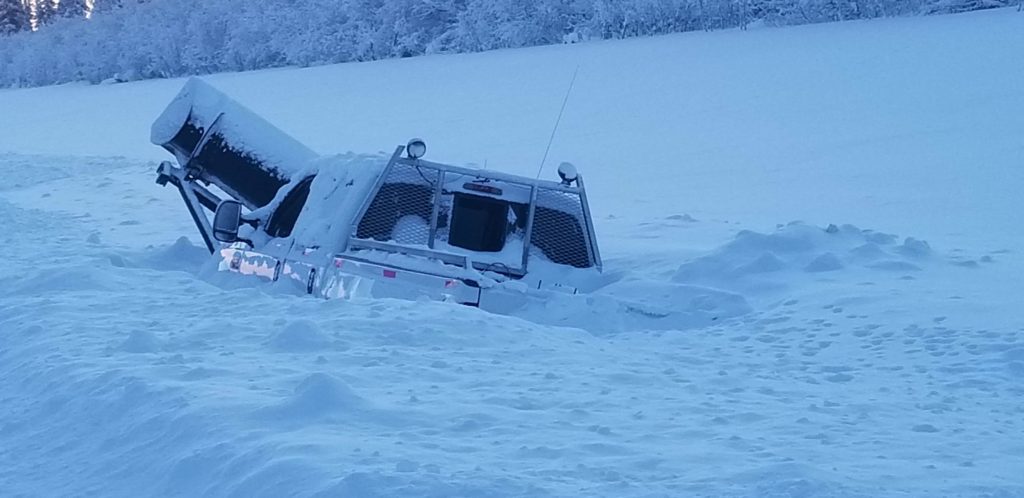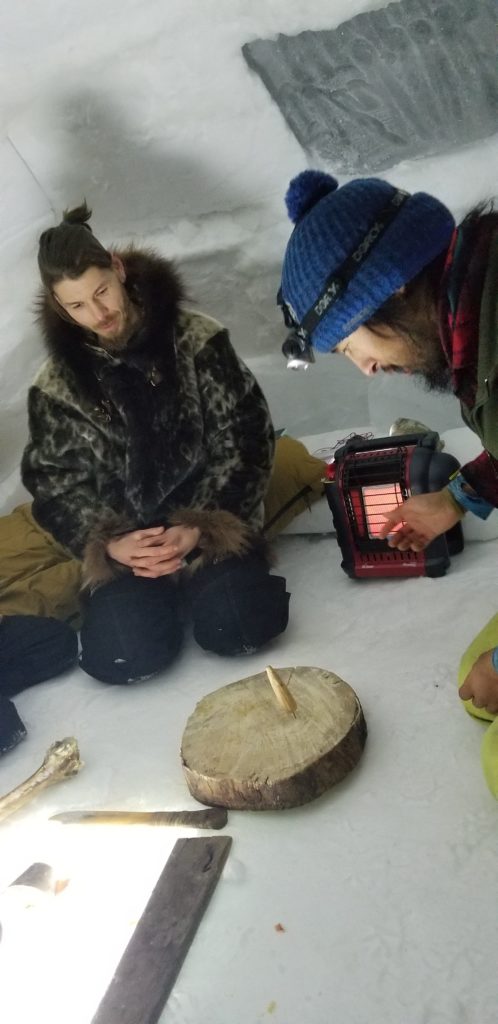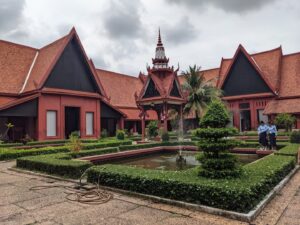
Jan 7 – Inuvik to Aklavik
To get a true Northern Arctic experience, our day’s journey took us to the remote village of Aklavik. For most of the year, this village is only accessible by boat or small airplane but at this time of the year, an ice road has been plowed over a 120 km stretch of the MacKenzie network of Rivers. While the trip is only half that distance as the crow flies, it is a winding road that weaves along rivers on the MacKenzie Delta.
The ice road was rated thick enough to carry 5-ton vehicles, but soon the river will be frozen enough to carry 4 times that weight and tanker trucks will be able to transport fuel and other supplies to Aklavik.
In Aklavik we visited our driver’s Aunt and Uncle who welcomed us into there small but warm wood stove heated home. Here they showed us all of the handicrafts they have made out of local products to sell to visitors. A few in our group bought moose antler knives and other souvenirs. The visit was short and a tour of the village took less than 15 minutes. Our driver who grew up in the area, told us about the old Hudson Bay trading post building and the cemetery where the world famous Mad Trapper is buried.
 We headed back to Inuvik shortly after the 1:27 pm Sunrise. With Sunset just over an hour later, there was already a significant amount more of sunlight to the day. Along the road, we stopped to look at a snow plow truck that was off to the side of the road. It had broken through the ice a little earlier in the season and was half filled with water. Now a bit later, it was well frozen into the Arctic ice on the river.
We headed back to Inuvik shortly after the 1:27 pm Sunrise. With Sunset just over an hour later, there was already a significant amount more of sunlight to the day. Along the road, we stopped to look at a snow plow truck that was off to the side of the road. It had broken through the ice a little earlier in the season and was half filled with water. Now a bit later, it was well frozen into the Arctic ice on the river.
We stopped in the early evening to get off of our bus close to our Igloo village accommodation for the evening. Tundra North Tours hiked us along a trail for a 10 minute guided walk that showed us an ice house. A hole 10 feet deep revealed ice crystals along the dirt permafrost walls to where goods could be stored year-round at below freezing temperatures. At this time of year, it is actually much warmer (-6°C) than the minus 38 degrees outside.
 A snowmobile picked some of us up to take us the final kilometer to the igloo village on the lake. It was 4 pm and the sun was setting as we arrived. The igloo village consists of 3 igloos for sleeping in, 1 cooking tent and one lounge tent complete with 3 large sofas. There is also a heated bathroom tent, an outdoor fire pit and ice bar surrounded by trees brought in to create the ambiance of a wooded grove. After warming up, we all had an opportunity to have some hands-on instruction on building an igloo. Our hosts showed us how level by level to build up the walls, tilting them inwards as we went up and how to position the weight of the blocks so that the top would not cave in. Because the snow here was not very wet, they also showed us how to mix snow with water to make some “Igloo Glue” to help cement the blocks together.
A snowmobile picked some of us up to take us the final kilometer to the igloo village on the lake. It was 4 pm and the sun was setting as we arrived. The igloo village consists of 3 igloos for sleeping in, 1 cooking tent and one lounge tent complete with 3 large sofas. There is also a heated bathroom tent, an outdoor fire pit and ice bar surrounded by trees brought in to create the ambiance of a wooded grove. After warming up, we all had an opportunity to have some hands-on instruction on building an igloo. Our hosts showed us how level by level to build up the walls, tilting them inwards as we went up and how to position the weight of the blocks so that the top would not cave in. Because the snow here was not very wet, they also showed us how to mix snow with water to make some “Igloo Glue” to help cement the blocks together.

In the evening we had a locally prepared dinner of caribou soup, Eskimo doughnuts and local conie fish. The caribou soup was a bit tough and the local fish was absolutely delicious.
Following dinner we went into the large igloo lit up by a light under a thick ice-block built into the floor of the igloo. It created a glow in the igloo with its stark white walls. Inside our host talked about some of the Arctic games and activities they would play to pass the time in the long cold winter nights. We also had an opportunity to taste some mukluk (whale) and raw arctic char. I have to admit the mukluk was hard to swallow and very oily while the arctic char was a bit slimy apart from the skin which was chewy like gum. Perhaps the acquired taste is developed as a child.
In the evening we gathered around the campfire in the freezing cold. Everyone else enjoyed some tea and Klondike ice cream bars while I attempted to trade in the tea for a root-beer float. Unfortunately, it had not taken more than 30 minutes for the ice cream to turn into freeze-dried ice cream powder like in the -38°C temperatures and the root beer just bubbled from the can as I attempted to open it up. It was more like a bubbling fountain of Root Beer and when it had finished fizzing, the can was as hard as a rock. So with nothing to put on my ice cream, I started to eat the powdered ice cream. What I forgot to realize was that the metal spoon was very cold and as soon as it hit my tongue, it stuck onto it like glue. It hurt a bit as the metal spoon ripped off my tongue. I had to be a bit more careful to pour in the rest of the ice cream powder from a distance.
I was very tired in the evening but nervous about sleeping in a frozen igloo. Fortunately, our camp had generators, heated blankets and soft warm sleeping bags for us to sleep in. Certainly some of the soft comforts not afforded to the indigenous people over the past couple of hundred years. There was even light inside and a plug to charge my phone. I was grateful that someone gave me some hand warmers to place in my socks as it did the trick to keep my toes warm. Before long I was sound asleep for the night. I only woke a few times to find my neck a bit cold and had wished I had brought a neck warmer. The moisture from my breath had created condensation at the top edge of my sleeping bag and as I attempted to tighten it around my neck to keep the heat in my sleeping bag, I had an icy cold shock for a few minutes as the icy cold fabric melted around my neck. Not to worry, I was snoring away to the benefit of my roommate.

